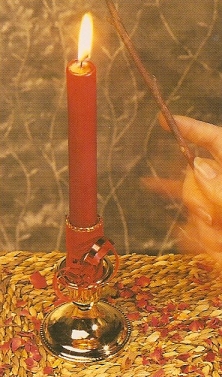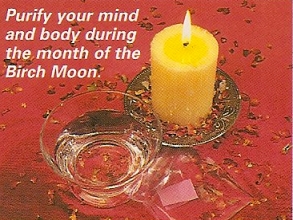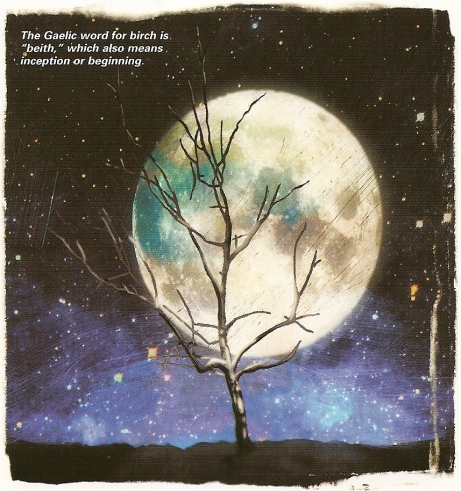The Celtic calendar begins with the month of the Birch Moon, a time of new beginnings and making plans for the future.
The first of the 13 months of the Celtic calendar is the month of the Birch Moon. It begins just after Yuletide and runs through most of January.
Staring just after the Winter Solstice – the shortest day of the year – the month of the Birch Moon marks the period of the year when the hours of daylight start to increase over the hours of darkness. Its associated color is flame red; from this comes the red candles that we burn at Yuletide.
New Year’s Resolutions
The month of the Birch Moon falls into the “quiet time” during the bleakest period of winter. None of the eight major Neopagan festivals occur in this month. There is little to do but wait for warmer weather.
This month is therefore primarily a time of contemplations, of looking to the future and starting to make plans for the year ahead- hence the tradition of making New Year’s resolutions.
THE LADY OF THE WOODS
The silvery bark that covers the trunk of the birch tree resembles the silver of the moonlight, which it reflects at night giving it a magical look.
With its long, slender branches that stretch up to the sky, the birch symbolizes the female aspects of nature and is often known as “the Lady of the Woods.” Growing up to 100 feet high, it has also been thought of as a ladder that shamans can climb to reach the gods.
BIRCH MOON MAGIC
The month of the Birch Moon is the ideal time to weave magic focusing on new beginnings and purification, or to cast spells for support, shielding and cleansing.
At the beginning of the year, concentrate on new beginnings. Ask for general luck in whatever the coming year brings, and focus on what you want to achieve.
Resolution Blessing Spell
The birch is the first tree to grow back after a forest has been cut down or razed, reinforcing its association with new beginnings. It is a tree of extreme hardiness, thriving in places where the oak cannot. When you make a New Year’s resolution, increase your chances of sticking to our guns by performing this blessing spell.
You Will Need:
- Red candle
- Red ribbon
- Birch wand
- Frankincense, rose, and benzoin essential oil
 1. Go for a walk in your local park and collect a birch twig no more than 12 inches long. As birch is a very common tree, you should be able to find one easily, even in urban areas and parks.
1. Go for a walk in your local park and collect a birch twig no more than 12 inches long. As birch is a very common tree, you should be able to find one easily, even in urban areas and parks.
2. Mix a few drops of rose frankincense and benzoin essential oil into the palm of your hand and rub the mixture into a red candle.
3. Light the candle, and stand in front of it for a few moments visualizing your resolution. If you are planning to learn to play guitar, for instance, visualize ourself happily strumming your favorite song. You may want to state your intent aloud, saying, “I will learn to play guitar.”
4. Holding your birch twig at one end, pass it through the candle’s flame. Then turn around, clockwise, holding the twig in front of you to draw a circle around yourself.
5. Repeat the incantation, “I manifest new chances for good fortune, clarity and insight. I open myself to new experience and allow change to manifest in my life.”
6. Now sit down for a few minutes and quietly contemplate your wish. When you have finished, blow out the candle.
Purification and Cleansing
 The silver color of the birch’s bark is associated with purity and cleansing. Criminals and naughty schoolboys were often beaten with birch twigs – “birched” – in order to purify them and drive out any evil influences.
The silver color of the birch’s bark is associated with purity and cleansing. Criminals and naughty schoolboys were often beaten with birch twigs – “birched” – in order to purify them and drive out any evil influences.
This is a good time to cleanse your mind of negative thoughts and attitudes, such as anger and jealousy, or an addictive behavior, such as smoking. A full Moon that calls within the month of the Birch Moon is called the Cold Moon; you can strengthen your intent by performing the following ritual at this time.
A Simple Cold Moon Ritual:
1. Light a white candle besides a small bowl of natural spring or rain water.
2. Stand over the water and pray for the strength to let go of your vice.
3. Write down your negative behavior nine times on a piece of paper.
4. Fold up the paper, place it inside a freezer bag, and pour in some of the prayer water.
5. Place the bag inside your icebox to “freeze” your bad habits – putting them behind your forever.
Birch Throughout the Year
- Birch is used for purification, exorcism and protection. A red ribbon tied to a birch twig will help ward off the evil eye.
- Witches’ brooms are made of birch twigs tied around an ash branch with strips of willow. The purifying birch sweeps away evil spirits, as well as dirt.
- At Beltane (May Day), birch twigs are used to light the fires that signal the beginning of the new season.
Source:
“Enhancing Your Body, Mind and Spirit”, 21 Nature Magic, CARD 5.
Suggested Links:
Celticradio.net, “Celtic Zodiac: The Birch“.
The Goddess Tree, “Birch“.
Jaecap. People.tribe.net, “The Birch Tree“.
Spiritblogger.wordpress.com, “Spirit Message of the Day – Celtic Tree Month Birch – Strength“.




























